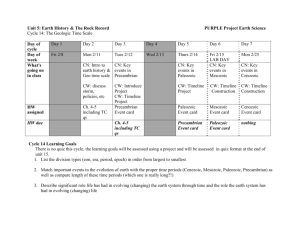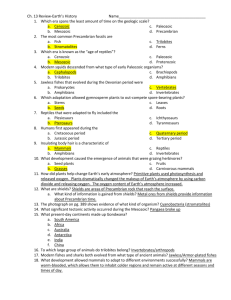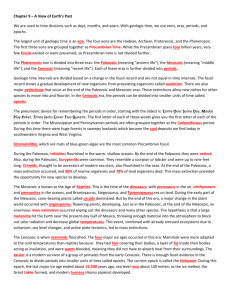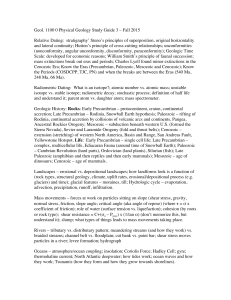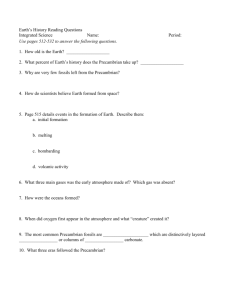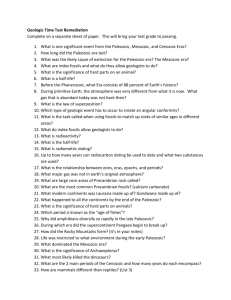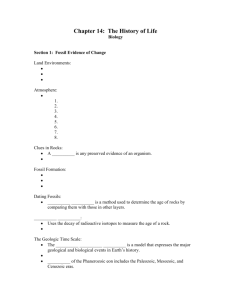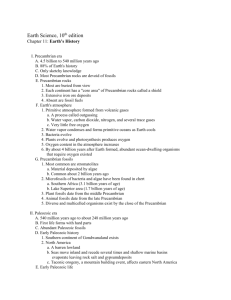Life and Geologic Time
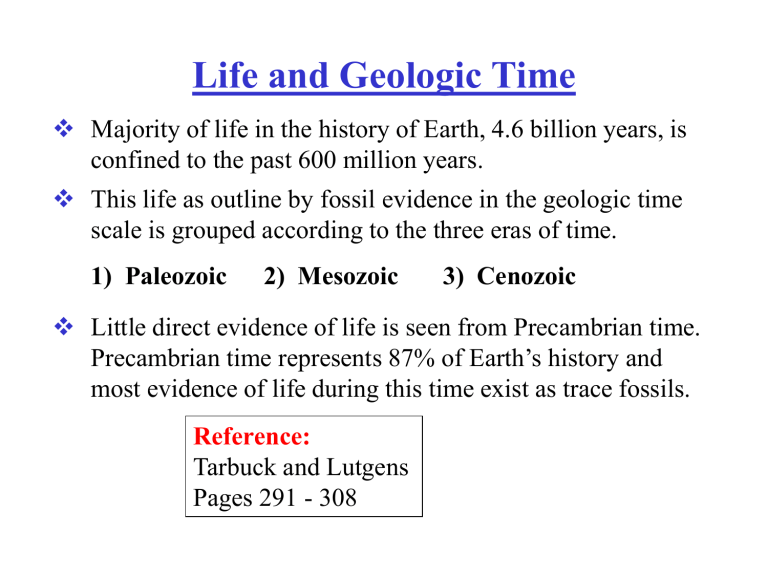
Life and Geologic Time
Majority of life in the history of Earth, 4.6 billion years, is confined to the past 600 million years.
This life as outline by fossil evidence in the geologic time scale is grouped according to the three eras of time.
1) Paleozoic 2) Mesozoic 3) Cenozoic
Little direct evidence of life is seen from Precambrian time.
Precambrian time represents 87% of Earth’s history and most evidence of life during this time exist as trace fossils.
Reference:
Tarbuck and Lutgens
Pages 291 - 308
Precambrian
(4600 – 570 million years ago)
Rocks from this time make up the core of all major land masses, called Precambrian shields.
Earliest evidence of life focuses on bacteria and algae seen in Precambrian rocks dating back to 3.5 billion years. This main fossil is called Stromatolites . Plant fossils are dated to the mid-Precambrian and animal fossil to the late
Precambrian, mainly as trace fossils.
As the Precambrian came to a close, the fossil record showed multi-cellular organisms which made it possible for the evolution of more complex plants and animals in the
Paleozoic era.
Paleozoic
(570 – 245 million years ago)
The beginning of the Paleozoic era is marked by the first appearance of life-forms which had hard body parts. Thus our knowledge of the diversity of life improves as throughout Paleozoic time.
Abundant fossils since the early Paleozoic allowed scientist to construct a detailed time scale for the last 13% of geologic time.
To study the vast amount and continually changing life, the
Paleozoic time can be divided as Early Paleozoic
(Cambrian, Ordovician, Silurian) and Late Paleozoic
(Devonian, Mississippian, Pennsylvanian, Permian).
Early Paleozoic
(570 – 408 million years ago)
Life during this time was restricted to the seas. Consisted of several invertebrate groups.
Organisms started to excrete material which formed hard outer coverings, such as shells. This may have been for protection.
Cambrian - Trilobite evolved.
Ordovician - Brachiopods and Cephalopods evolved.
- First fish (vertebrate) evolved.
Silurian - First land plants appear.
Late Paleozoic
(408 - 245 million years ago)
Plant life at the waters edge moved in land and formed forests by the end of the Devonian.
In the oceans the first fish (armor-plated fish) evolved to become more mobile.
Devonian
Marked the evolution of; sharks and first bony fish. This period is referred to as the “age of fishes.”
Lung fish and lobe-finned fish adapt to land environments.
It is believed that these organisms evolved into amphibians by the end of the Devonian period.
Late Paleozoic
(408 - 245 million years ago)
Plant life at the waters edge moved in land and formed forests by the end of the Devonian.
In the oceans the first fish (armor-plated fish) evolved to become more mobile.
Mississippian and Pennsylvanian
Insects and amphibians abundant on land.
Large coal swamps present.
It is believed that the first retile evolved during this time.
Possibly from one species of amphibians.
Late Paleozoic
(408 - 245 million years ago)
Plant life at the waters edge moved in land and formed forests by the end of the Devonian.
In the oceans the first fish (armor-plated fish) evolved to become more mobile.
Permian
Reptile increase in numbers.
Mass extinctions of approx 95% of all life. Possible explanation involve the formation of the supercontinent
Pangaea. Extinction of trilobite is most common example.
Mesozoic
(245 - 70 million years ago)
Organisms that survived the extinction began to diversify .
On land the dinosaur became dominant and this era is called the “age of reptiles – dinosaur.”
Drier climates dominated during this era and life had to adapt. Gymnosperms (seed bearing plants) and reptiles dominated land environments.
Reptiles have shell covered eggs that could be laid on land.
This eliminated the water stage of reproduction as seen with amphibians. This one evolution break through enabled reptiles to dominate Earth for the next 160 million years until the end of the Mesozoic, 66 million years ago.
Mesozoic
(245 - 70 million years ago)
One form of reptile made a remarkable step in evolution, it was the first to take to the sky and fly. These were referred to as dragons of the sky, and were called the pterosaurs.
Jurassic time marked the first evidence of birds in the fossil record.
First flowering plants evolved at the end of the Jurassic period.
At the end of the Mesozoic many reptile groups became extinct. Many dinosaur groups are only known through the fossil record.
Cenozoic
(66 million years ago to Present)
Life during this time evolved into the modern life-forms.
Mammals replaced the reptiles as the dominant animals on
Earth. This era is called the “age of mammals.” Flowering plants became the more dominant plant life.
The development and specialization of mammals throughout the Cenozoic took four main directions;
1) Increase in size.
2) Increase in brain capacity.
3) Specialization of teeth.
4) Specialization of limbs.
